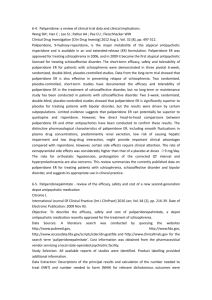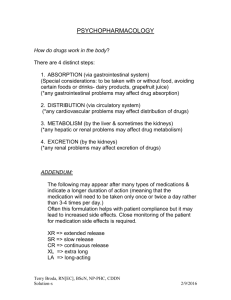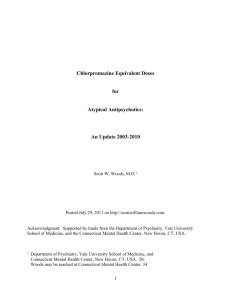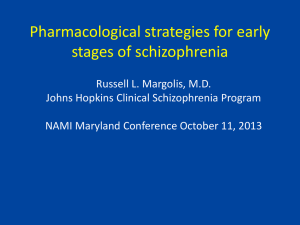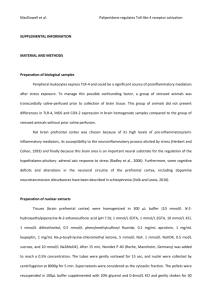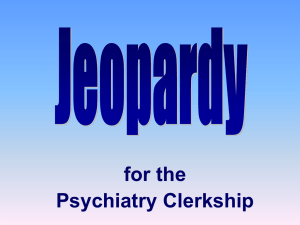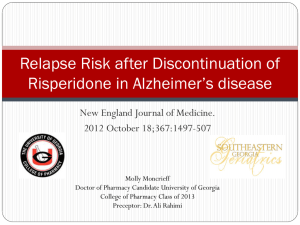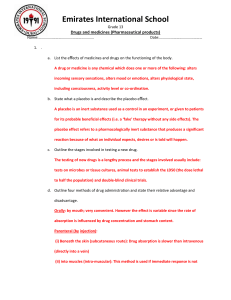Paliperidone Extended
advertisement
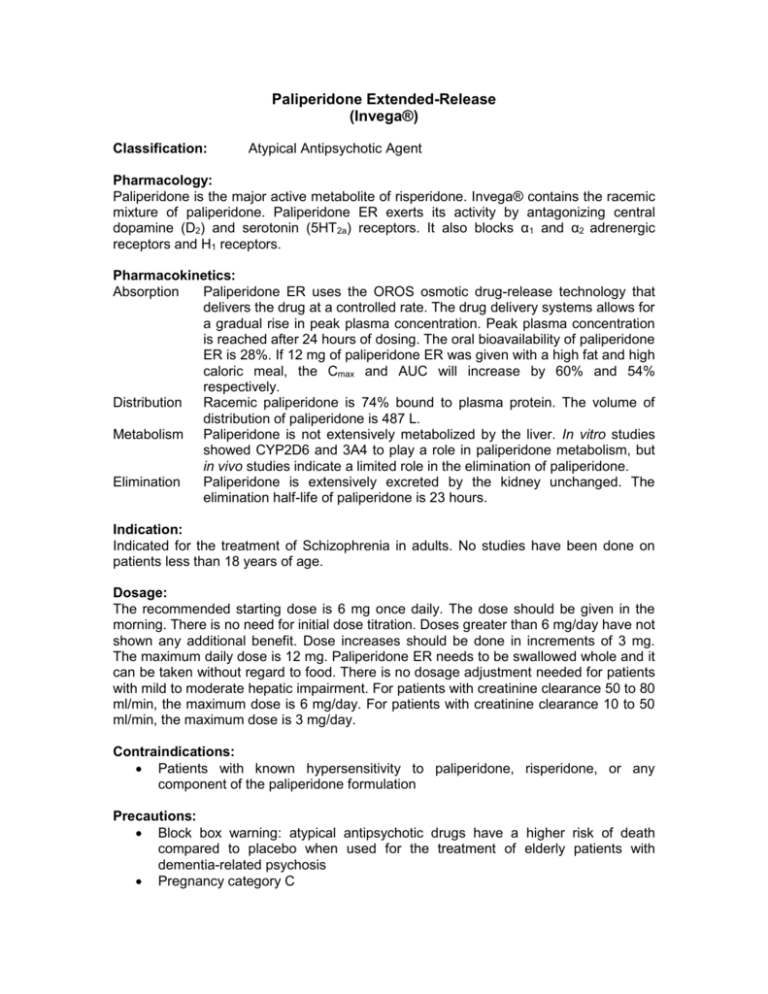
Paliperidone Extended-Release (Invega®) Classification: Atypical Antipsychotic Agent Pharmacology: Paliperidone is the major active metabolite of risperidone. Invega® contains the racemic mixture of paliperidone. Paliperidone ER exerts its activity by antagonizing central dopamine (D2) and serotonin (5HT2a) receptors. It also blocks α1 and α2 adrenergic receptors and H1 receptors. Pharmacokinetics: Absorption Paliperidone ER uses the OROS osmotic drug-release technology that delivers the drug at a controlled rate. The drug delivery systems allows for a gradual rise in peak plasma concentration. Peak plasma concentration is reached after 24 hours of dosing. The oral bioavailability of paliperidone ER is 28%. If 12 mg of paliperidone ER was given with a high fat and high caloric meal, the Cmax and AUC will increase by 60% and 54% respectively. Distribution Racemic paliperidone is 74% bound to plasma protein. The volume of distribution of paliperidone is 487 L. Metabolism Paliperidone is not extensively metabolized by the liver. In vitro studies showed CYP2D6 and 3A4 to play a role in paliperidone metabolism, but in vivo studies indicate a limited role in the elimination of paliperidone. Elimination Paliperidone is extensively excreted by the kidney unchanged. The elimination half-life of paliperidone is 23 hours. Indication: Indicated for the treatment of Schizophrenia in adults. No studies have been done on patients less than 18 years of age. Dosage: The recommended starting dose is 6 mg once daily. The dose should be given in the morning. There is no need for initial dose titration. Doses greater than 6 mg/day have not shown any additional benefit. Dose increases should be done in increments of 3 mg. The maximum daily dose is 12 mg. Paliperidone ER needs to be swallowed whole and it can be taken without regard to food. There is no dosage adjustment needed for patients with mild to moderate hepatic impairment. For patients with creatinine clearance 50 to 80 ml/min, the maximum dose is 6 mg/day. For patients with creatinine clearance 10 to 50 ml/min, the maximum dose is 3 mg/day. Contraindications: Patients with known hypersensitivity to paliperidone, risperidone, or any component of the paliperidone formulation Precautions: Block box warning: atypical antipsychotic drugs have a higher risk of death compared to placebo when used for the treatment of elderly patients with dementia-related psychosis Pregnancy category C Patients with QT prolongation Patients with orthostatic hypotension, hyperprolactinemia, or dysphagia Interactions: Paliperidone ER may block the effects of dopamine agonists and levodopa. The use of paliperidone ER with other agents that can cause orthostatic hypotension may have an addictive effect Combination of other centrally acting drugs and alcohol should be used with caution with paliperidone ER Adverse Reactions: Possible side effects are headache, akathisia, extrapyramidal disorders, sedation, agitation, anxiety, tachycardia, increased blood sugar, and QT prolongation. Clinical trials show no significant difference in weight gain between placebo, 3mg paliperidone ER, and 6mg paliperidone ER. There was a higher incidence of weight gain in patients taking 9 mg or 12 mg compared to placebo. A rare, but serious side effect is neuroleptic malignant syndrome which is characterized by muscle rigidity, fever, altered mental status, acute renal failure, rhabdomyolysis, and irregular blood pressure. Costs and Monitoring: Invega® 3mg & 6mg: $9.46 per tablet Invega® 9mg: $14.19 per tablet Invega® 12mg: $18.92 (given as two 6mg tablets) Invega® is not currently available in unit dose. Like other atypical antipsychotics baseline BMI, FPG or HbgA1c, fasting lipid panel, EPS evaluation and TD assessment should be conducted and ongoing BMI, FPG or HbgA1c, fasting lipid panel, inquiry for prolactin elevation, EPS evaluation, and TD assessment should be performed. Product Identification: Tablets: 3 mg (white), 6 mg (beige), and 9 mg (pink) Efficacy: The efficacy of paliperidone ER for the treatment of acute schizophrenia episodes in adults (n=630) was demonstrated in a placebo-controlled, active-controlled (olanzapine), 6-week, fixed-dose study.1 Patients were randomized to receive a fixed-dose of 6 mg, 9 mg, or 12 mg paliperidone ER, or 10 mg olanzapine, or placebo once daily in the morning. Total scores on the Positive and Negative Syndrome Scale (PANSS) decreased by -17.9, -17.2, and -23.3 for the 6mg, 9mg, and 12mg paliperidone ER groups respectively (p<0.001 for all paliperidone ER groups versus placebo), and -19.9 for the olanzapine group; the PANSS score changed by -4.1 for the placebo group. The adverse events with a higher incidence in the paliperidone ER groups compared to placebo are EPS (7% vs. 1%), hyperkinesia (7% vs. 3%), hypertonia (3% vs. 0%), tachycardia (18% vs. 10%), increased saliva (3% vs. 1%), vomiting (3% vs. 2%), ECG abnormalities (5% vs. 2%), postural hypotension (4% vs. 1%). Prolactin levels increased from 17.4 ng/ml at baseline to 45.3 ng/ml at the end of the trial in males receiving paliperidone ER; in females receiving paliperidone ER, the prolactin levels rose from 38.0 ng/ml to 145.3 ng/ml. Prolactin levels slightly decreased in both males and females receiving placebo or olanzapine. No significant increases in glucose, insulin, or serum lipid levels were seen in any of the paliperidone ER groups. A weight increase of ≥7% was observed in 2% of the placebo group, 3-7% of the paliperidone ER groups, and 13% of the olanzapine patients. The efficacy of paliperidone ER for the treatment of schizophrenia in adults age 18-65 was demonstrated in a 8 week run-in open-label flexible dose (3-15 mg/day, starting dose 9mg) phase, followed by a 6 week open-label fixed dose phase (effective dose established during the run-in phase continued), then subjects entered the double-blind treatment phase of variable duration (patients remained in the double-blind phase until they experienced a recurrent event, withdrew, or study was completed- average length 24 weeks).2 For the patients in the paliperidone ER group, 38% were stabilized on 9 mg/day, 22% on 12 mg/day, 28% on 15 mg/day, and 12% were tapered down to 3 mg/day or 6 mg/day. The primary measure, rate of recurrence, was significantly higher in the placebo group (52%) versus the paliperidone ER group (22%) with a significance level of p<0.001. Treatment-emergent adverse events (TEAEs) occurring most often with paliperidone ER in the open-label phases were tremors (16%), tachycardia (15%), headache (14%), hyperkinesias (12%), and insomnia (10%). During the double-blind portion of the trial, 7% of patients receiving paliperidone ER reported extrapyramidal symptoms compared to 3% receiving placebo. Prolactin levels were elevated in the paliperidone ER group; the prolactin levels had a slight decrease in the placebo group (exact values not disclosed). Prolactin related adverse events (amenorrhea, nonpuerperal lactation) were more common with paliperidone ER (4%) vs. placebo (0%). One report of possible NMS in the paliperidone ER group. After following the patients for an average of 24 weeks, those in the paliperidone ER group gained an average of 1.8 kg, the placebo group averaged a 0.2 kg weight gain. Clinically significant weight gain (≥ 7%) occurred in 12% of placebo treated patients and 20% of paliperidone ER treated patients. There were no statistically significant differences in C-peptide, glucose, insulin, or lipid levels between the paliperidone ER and placebo group at endpoint. The potency of Invega® was demonstrated in a “virtual” comparison of paliperidone ER and risperidone.3 Three randomized, placebo-controlled studies for paliperidone ER and for risperidone were pooled. Patients who received either paliperidone ER 6 to 12 mg/day (n=275), risperidone 2 to 4 mg/day (n=173), risperidone 4 to 6 mg/day (n=174), or placebo (n=360), and were aged 18-65, were included in this analysis. The completion rates of paliperidone ER 6 to 12 mg/day and risperidone 4 to 6 mg/day were similar (67.6% and 65.5%), compared to a 40.8% completion rate for the placebo group. The PANSS score changes at endpoint were not significantly different for the paliperidone ER and risperidone groups, -19.0 and -19.7 respectively (P=0.825). Mean weight gain with paliperidone ER was 0.7 kg and risperidone 1.3 kg (P=0.024). The risperidone 4 to 6 mg/day group was associated with higher rates of akathisia, restlessness, anxiety, insomnia, somnolence, dizziness, and gastrointestinal side effects than the paliperidone ER group. The paliperidone ER 6 to 12 mg/day and risperidone 2 to 4 mg/day groups had completion rates of 67.6% and 53.8%, respectively (P=0.003). The paliperidone ER group had a superior mean PANSS reduction of -19.0 compared to the risperidone 2 to 4 mg/day reduction of -11.4 (P=0.003). The paliperidone ER group reported fewer incidents of akathisia, restlessness, insomnia, somnolence, dizziness, and gastrointestinal effects, but an increased incidence of tachycardia. Weight gain occurred, but there was no significant difference in weight gain between the groups. This study concluded that paliperidone ER 6 to 12 mg/day is more comparable to risperidone 4 to 6 mg/day. The studies were conducted throughout North America, Eastern and Western Europe, and Asia. Upon examination, no differences in response were found between population subgroups based on gender, geographic location, or age. Sufficient data was not collected during these studies to determine if a differential response based on race exists.1 Conclusions: Studies show paliperidone ER is an effective treatment for schizophrenia. To date, no studies have shown paliperidone ER to be more effective than any other atypical antipsychotics. One advantage of paliperidone ER is the osmotic pressure delivery system, OROS, allowing for effective once daily dosing. While some other antipsychotics are approved for once daily dosing, this is currently the only antipsychotic using OROS technology. Since there have not been any direct head to head comparisons with risperidone it is unclear if paliperidone ER is better tolerated. One disadvantage of paliperidone ER is the price. Comparable effects are achieved from paliperidone ER 6 mg/day and risperidone 4 mg/day, costing $9.46 and $9.04, respectively. At the higher comparable doses; however, paliperidone ER 12 mg/day (two 6 mg tablets) is $18.92, and risperidone 6 mg/day is $13.46. At this time, paliperidone ER does not come in unit dose form, adding time and cost to repackage the medication. In addition, risperidone is anticipated to be available generically by the end of 2007. Recommendation: Not recommended for addition to the formulary. References: 1. Kane J, et al. Treatment of Schizophrenia With Paliperidone Extended-release Tablets: A 6-Week Placebo-controlled Trial. Schizophrenia Research 2007;90(13):147-61. 2. Kramer M, Simpson G, Maciulis V, et al. Paliperidone Extended-release Tablets for Prevention of Symptom Recurrence in Patients With Schizophrenia: A Randomized, Double-blind, Placebo-Controlled Study. Journal of Clinical Psychopharmacology. 2007:(27)6-14. 3. Schooler N, Gharabawi G, Bossie C, et al. A “Virtual” Comparison of Paliperidone ER and Oral Risperidone in Patients With Schizophrenia [poster]. Presented at: 45th Annual Meeting of the American College of Neuropsychopharmacology 2006; December 3-7, 2006; Hollywood, Fla. 4. Invega Package Insert. Janssen. Titusville, NJ. December 2006. Prepared by: Joseph Jessup and Dana Leung, Pharm.D. Interns Reviewed by: Lisa M. Mican, Pharm.D., BCPP Assistant Pharmacy Director Austin State Hospital February 15, 2007
